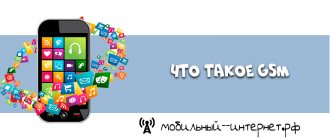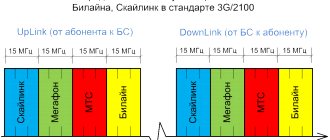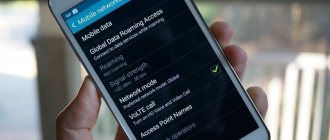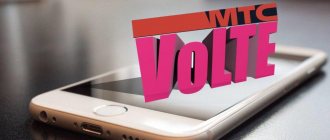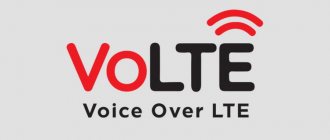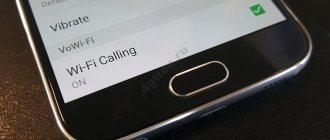The idea of wireless mobile communications originated in the minds of scientists at the beginning of the 20th century. Work on creating a radiotelephone communication system was actively carried out both in Western countries and in the Soviet Union, but the first working model of a cell phone appeared only in 1973, when the American company Motorola introduced the world DynaTac - the first prototype of a portable cell phone. Today, it is almost impossible to imagine human life without mobile devices using wireless communication technologies. Over the past 35 years, 4 generations of cellular communications have changed, and the fourth is being replaced by the fifth generation, the introduction of which is expected by 2021. The history of the development of cellular communications, generations and technologies used will be discussed in this article.
First generation - 1G
All first-generation standards were analog and had a lot of shortcomings. There were problems with both signal quality and technology compatibility. Among the first generation mobile communication standards, the most widely used are the following: • AMPS (Advanced Mobile Phone Service). Used in the USA, Canada, Australia and South America; • TACS (Total Access Communications System) Used in European countries such as England, Italy, Spain, Austria and a number of other countries; • NMT (Nordic Mobile Telephone – Nordic mobile phone). Used in Scandinavian countries. • TZ-801 (TZ-802,TZ-803), developed in Japan. Despite existing problems with quality and compatibility of standards, analogue mobile communication networks have still found commercial application. The Japanese were the first to do this in 1979, then in 1981 the analogue network was launched in Denmark, Finland, Norway and Sweden, and in 1983 in the USA.
Interoperability of networks and international roaming
UMTS and GSM use different mechanisms at the air interface level and are therefore not compatible. However, recent developments among UMTS mobile terminals and access cards sold in Europe, the USA, North Africa and most of Asia allow operation in networks of both standards. If a UMTS subscriber leaves the UMTS coverage area, his terminal automatically switches to receiving and sending signals in GSM format (even if the networks are served by different telecom operators). However, GSM mobile terminals cannot be used in UMTS networks.
Second generation - 2G
In 1982, the European Conference of Postal and Telecommunications Authorities formed a working group called GSM (French Groupe Spécial Mobile - special group for mobile communications). The purpose of creating the group is to study and develop a pan-European terrestrial mobile communication system for general use. In 1989, the European Telecommunications Standards Institute continued the study and development of the second generation of mobile communications. The abbreviation GSM then acquired a different meaning - Global System for Mobile Communications (global system for mobile communications). In 1991, the first commercial second generation mobile networks appeared. The main difference between second-generation networks and the first is the digital method of data transmission. Digital data transmission technologies made it possible to introduce a text messaging service (SMS), and later, using the WAP (Wireless Application Protocol) protocol, it became possible to access the Internet from mobile devices. The data transfer speed in second generation networks was no more than 19.5 kbit/s. The further increase in user demand for mobile Internet provided the impetus for the development of next-generation networks. The intermediate stages between 2G and 3G networks were generations conventionally called 2.5G and 2.7G . 2.5G generation was designated GPRS (General Packet Radio Service) technology, which made it possible to increase the data transfer rate to 172 kbit/s in theory, and up to 80 kbit/s in reality. 2.7G generation is called EDGE (EGPRS) technology (Enhanced Data rates for GSM Evolution), which functions as an add-on over 2G and 2.5G. The data transfer speed in such networks can theoretically reach 474 kbit/s, but in practice it rarely reaches 150 kbit/s.
Operating principle of UMTS
What this is has already become clear from the previous description, but how such a network works is worth understanding. In the CN block, the most important operations are performed, which boil down to connecting the mobile station to the network, its further paging, cellular selection and localization of the subscriber, making incoming and outgoing calls, handover of the subscriber between base stations. CN is divided logically into two domains – CS and PS. The base station is responsible for radio signal processing, channel encoding and rate adaptation, and much more. In addition, it controls the power in the internal loop. UMTS cellular communications can implement connections with various external networks, which are divided into two groups: circuit switched and packet switched. The first option is for telephone communication, and the second is for connecting to the Internet. Since the switching center coordinates its work with fixed networks, it has all the functions that are required for circuit switching and is also responsible for managing the connection. The switching center performs the procedures that are required for handover and location registration.
Third generation - 3G
Work on creating third-generation technologies began in the 1990s, and implementation took place only in the early 2000s (in 2002 in Russia). The standards developed by that time were based on CDMA (Code Division Multiple Access) technology. The third generation of mobile communications includes 5 standards: UMTS/WCDMA, CDMA2000/IMT-MC, TD-CDMA/TD-SCDMA, DECT and UWC-136. The most common of them are the UMTS/WCDMA and CDMA2000/IMT-MC standards. In Russia, the UMTS/WCDMA standard has gained popularity. Next, we propose to dwell on the main 3G technologies:
UMTS
UMTS (Universal Mobile Telecommunications System) is a cellular communication technology developed for the introduction of 3G in Europe. The frequency range used is 2110-2200 MHz. (often the channel width is 5 MHz). The data transfer speed in UMTS mode is no more than 2 Mbit/s (for a stationary subscriber), and when the subscriber moves, depending on the speed of movement, it can drop to 144 Kbit/s.
HSDPA
HSDPA (High-Speed Downlink Packet Access - high-speed packet data transfer from a base station to a mobile phone) is the first of the HSPA (High Speed Packet Access) family of cellular communication protocols, based on UMTS technology. This protocol and its subsequent versions have made it possible to significantly increase data transfer speeds in 3G networks. In its first implementation, the HSDPA protocol had a maximum data transfer rate of 1.2 Mbit/s. The data transfer rate in the next implementation of the HSDPA protocol was already 3.6 Mbit/s. At this point, 3G modems became very popular and most users had modems that supported this particular standard, the most popular models being Huawei E1550, ZTE mf180 (such examples are still found today). As a result of further development of the HSDPA protocol, it was possible to increase the speed first to 7.2 Mbit/s (the most popular modems are Huawei E173, ZTE MF112), and then to 14.4 Mbit/s. (Huawei E1820, ZTE MF658) The pinnacle of HSDPA technology was DC-HSDPA technology, the speed of which could reach 28.8 Mbit/s. DC-HSDPA is essentially a two-channel version of HSDPA.
HSPA+
HSPA+ is a technology based on HSDPA, which implements more complex signal modulation methods (16QAM, 64QAM) and MIMO technology (Multiple Input Multiple Output). The maximum 3G speed can reach 21 Mbps. A similar technology is already classified as 3.5G .
DC-HSPA+
DC-HSPA+ technology with the fastest 3G Internet 42.2 Mbit/s. This is essentially two-channel HSPA+ with a channel width of 10 MHz. This technology is often called 3.75G .
All devices that support third generation networks also support the standards of previous generations. For example, the now outdated Huawei E173 USB modem for 2G/3G networks supports GSM, GPRS, EDGE (up to 236.8 Kbps), UMTS (up to 384 Kbps), HSDPA (up to 7.2 Mbit/s), i.e. network standards of both second and third generations. The maximum speed with which this device can operate is 7.2 Mbit/s. The more “advanced” model Huawei E3131 for 2G/3G networks supports a set of standards, including, in addition to the above, HSPA+. The maximum achievable download speed on this device is much higher and is 21 Mbit/s. But it should be taken into account that the maximum theoretical and real speeds differ quite significantly. For example, on Huawei E1550, zte mf180 modems, where the maximum speed is 3.6 Mbit/s, in practice you can achieve a speed of 1-2 Mbit/s, on Huawei E173, ZTE MF112 modems (maximum speed 7.2 Mbit/s) in practice 2-3.5 Mbit/s, this is subject to good signal level and low load on the mobile operator tower. One of the factors for increasing 3G Internet speed is to use a modem that supports maximum 3G speed. We recommend the Huawei E3372 ; it not only supports maximum 3G Internet speed (up to 42.2 Mbit/s), but also 4G (up to 150 Mbit/s).
Someone may object and say that there will never be 4G in their “hole,” but don’t forget that a few years ago you didn’t even dream about 3G. Technology does not stand still!
What is the difference between WCDMA and GSM
GSM is a cellular communication standard that dates back to the late 1980s. It uses frequencies ranging from 800 to 1900 MHz and provides basic cellular services.
For example, using GSM you can:
- Make voice calls;
- Send short text messages (SMS);
- Send fax messages;
- Access the Internet (WAP, GPRS);
In addition, GSM can provide a number of additional services, including: caller ID, call forwarding, call holding and waiting, conferencing, voice mail.
As you can see, GSM provides basic mobile services, while WCDMA is a cellular standard that was created as a complement to GSM. The WCDMA standard operates in the frequency range from 1900 to 2100 MHz and is used to provide access to third generation (3G) mobile communications services.
Also WCDMA and GSM work differently with frequencies and channels. GSM uses time and frequency division (TDMA and FDMA), while WCDMA uses code division (CDMA). Using CDMA has a number of advantages over TDMA and FDMA:
- Efficient use of resources. Code division does not limit the number of possible channels so much.
- High level of protection. The use of code division significantly complicates the selection of a separate channel, since the entire frequency band is almost evenly filled with the signal.
- Save battery power. Phones that work with CDMA have less radiation power, which saves battery power.
Fourth generation - 4G
3G, which has not yet exhausted its capabilities, is being replaced by new technologies, fourth generation technologies (4G), which better meet the needs of the times. Technologies of the 4G generation have identified completely new requirements for the quality of the communication signal and its stability. The brainchild of joint research between Hewlett-Packard and NTT DoCoMo in the development of data transmission technologies in fourth-generation wireless networks became the LTE and WiMax standards. • The WiMAX standard was developed in 2001 by the WiMAX Forum, which includes manufacturers such as Samsung, Huawei Technologies, Intel and other well-known companies. Conceptually, WiMAX is a continuation of the Wi-Fi wireless standard. Versions of the WiMAX standard are divided into fixed, intended for stationary subscribers, and mobile, for moving subscribers at a speed not exceeding 115 km/h. The first commercial WiMAX network was launched in Canada in 2005. • The LTE standard (Long-Term Evolution) is essentially a continuation of the development of the GSM/UMTS standards and initially did not belong to the fourth generation of mobile communications. Today, LTE is the main standard for fourth generation networks (4G). First introduced by the aforementioned NTT DoCoMo, the world's largest Japanese cellular operator, LTE, in its tenth release LTE Advanced, was chosen by the International Telecommunication Union as the standard that meets the requirements of fourth generation wireless communications. The first commercial implementation of an LTE network was carried out in 2009 in Sweden and Norway. The maximum theoretical data transfer speed in LTE networks is 326.4 Mbit/s. In practice, the data transfer rate significantly depends on the frequency band used by the operator. The cellular operator Megafon currently has the largest frequency range (40 MHz), which is a serious advantage over other domestic cellular operators that use a bandwidth of 10 MHz. The maximum data transfer rate in an LTE network with a 10 MHz band width is 75 Mbit/s. Well, the maximum data transfer speed when using a 40 MHz band width can reach 300 Mbit/s.
Which mode to choose
WCDMA is a new generation mobile communication mode (3G). Voice and data can be transmitted through it, and this happens much faster. The quality of communication is practically the same in these modes. But WCDMA coverage most often does not work outside the city.
Therefore, if you often travel outside the city limits and communication is important to you, choose GSM. And if you are most often in the city and want to use high-speed Internet, WCDMA is more suitable for you. The advantage of this network mode is that it saves battery power, and the connection will not be glitchy while moving around the city.
You can also select automatic mode (switching between networks depending on the quality of coverage). It will provide Internet and voice communications anywhere within reach of radio waves. But its disadvantage is increased energy consumption, because two radio modules operate simultaneously.
And since the radio module uses more energy where the signal is poorly accessible, the battery will discharge very quickly outside the city. Therefore, when leaving, switch to GSM.
To enable the required network mode in smartphones supporting Android OS (Meizu, Xiaomi, Lenovo, Prestigio, etc.), go to Settings > Mobile networks > Network mode > enable WCDMA / GSM / UMTS / HSDPA+.
That's all, friends! I hope the article was useful to you. Share it with your friends, don't forget to like and subscribe to us on Facebook Twitter and VKontakte! See you!
Fifth generation - 5G
Work on developing new standards for wireless data transmission continues unabated. Mainly with the sponsorship of one of the largest manufacturers of network equipment, the Chinese company Huawei. The widespread introduction of fifth-generation technologies is predicted in 2021. There is no clear information regarding the maximum data transfer speeds in 5G networks yet, but it is known that in pilot tests of 5G networks it was possible to achieve speeds of 25 Gbit/s. This is tens of times higher than the maximum data transfer rates in fourth generation networks.
additional characteristics
New generation networks are characterized by the presence of a QoS function with a set of priorities: streaming, conversational, background and interactive. As already mentioned, when moving to 3G networks, UMTS is used. What it is has been described in sufficient detail
It is important to note that the final implementation of such a transition requires the replacement of both subscriber terminals and base station subsystems. In addition, much of the equipment currently used at the core network level needs to be replaced.
The network architecture is significantly different in that the switch is divided into two independent levels - switching and signaling processing with service control. All this is evidence that for the subsequent transition to new generation networks, it will be necessary to modernize the subsystems of base stations and subscriber terminals. New UMTS bands and the implementation of all these goals will require the creation of electronic components and the attraction of huge investments.
GPRS terminal equipment
Terminals remain in demand among sellers in stores and shopping centers. As you know, the Ethernet signal disappears for various reasons, but mobile communications are considered stable. The second data transmission channel increases the chance of a successful transaction. The terminal sends a signal to the server and reads the payment data. Main characteristics:
- encryption type;
- supported certificates;
- dimensions;
- processor performance;
- RAM internal memory;
- average frequency;
- system power.
How to enable GPRS on an Android device?
On any device running the Android operating system, you can manually set network connection parameters. If in normal settings you can only choose between generations (2G, 3G, 4G, etc.), then in a special engineering menu there is the possibility of more detailed settings:
Step 1: Open the Phone app on your smartphone and expand the number pad.
Step 2. Enter the code “*#*#4636#*#*” to go to the engineering menu.
Step 3. In the window that appears, select the “Phone Information” section and go to it.
Step 4. Find the line “Set up your preferred network type:” and click on it to expand the full list.
Step 5. Select “GSM only” and close the menu.
You won’t find GPRS technology itself in the list, since it is an add-on to GSM (like, for example, HSPA) and with a 99% probability it will work by default on any modern device. To check this, just try going online.
Technology comparison
Users are wondering which is better, WCDMA or GSM, what is the difference between these two standards?
It is difficult to give a definite answer, because all technologies are unique in their own way.
- As the name suggests, VSDMA uses a wider bandwidth than its counterpart. While SDMA uses sets that are only 1.25 MHz wide, VSDMA uses bands that are 5 MHz wide.
- Both mobile phone standards also differ in terms of the technologies with which they are grouped; since VSDMA uses 3G technology and SDMA uses 2G technology. The fact that CDMA uses 2G technology also puts it in direct competition with the most widely used GSM standard for mobile phones, which in turn puts it in competition with GSM-CDMA.
- On the other hand, WCDMA standard is used along with GSM to provide 2G and 3G technologies in a certain area. (It is important to note that 3G technology, represented by CDMA-CDMA2000 or EV-DO, is a direct competitor to WCDMA.) The fact that WCDMA is part of the 3G system makes it faster than its 2G counterpart.
In the end, it is safe to conclude that WCDMA is faster than CDMA , and this explains why many people change base. Its biggest advantage is its ability to work in tandem with GSM. If current trends are to be believed, WCDMA is expected to win this battle sooner or later.
Competing standards
Despite the fact that UMTS implements the latest developments in the use of the air interface, FOMA, CDMA2000 and TD-SCDMA networks are considered competitive with this technology. Of these, only FOMA assumes the use of W-CDMA.
In principle, the competing standard is determined based on the configuration of UMTS itself. If UMTS is aimed at data transmission, then WiMAX, Flash-OFDM and LTE technologies are considered competing. This article discusses aspects of UMTS-FDD systems, a form of UMTS proposed for use in traditional cellular networks. Another form of UMTS, UMTS-TDD, which is based on a different technology over the air (TD-CDMA) than W-CDMA, offers data exchange between the base station and the mobile terminal in the same spectrum, which is an effective solution for providing separate access. In this case, we can talk about a more competitive solution in relation to networks similar to WiMAX than those focused on UMTS voice traffic.
Both CDMA2000 and W-CDMA are agreed upon by the International Telecommunication Union as part of the 3G generation IMT-2000 family in addition to TD-CDMA, EDGE technologies and China's own TD-SCDMA standard.
The narrower bandwidth of CDMA2000 compared to UMTS makes it much easier to launch this technology in places where older networks are in operation. For a number of reasons, telecom operators may operate either UMTS or GSM, but not both technologies, in the same frequency band at the same time. However, this is not a big problem, since in most regions the deployment of two networks in the same spectrum is already limited by law.
Most GSM operators in North America, as well as operators in other regions, use EDGE equipment as the closest technology to 3G. The American AT&T Wireless offered this service to its subscribers in 2003, T-Mobile USA - in October 2005, and the Canadian Rogers Wireless - at the end of 2003. The Lithuanian operator Bitė Lietuva was one of the first European operators to offer EDGE to users (December 2003), the Italian company TIM did so in 2004. The advantage of EDGE is that it can be used in the frequency band occupied by GSM and the ease of its implementation in mobile terminals for phone manufacturers. This is a lightweight, easy-to-use and relatively inexpensive technology that serves as a temporary solution for upgrading GSM networks: UMTS requires more significant investments and changes in the provider's architecture. The main competitor to this application to networks is CDMA2000.
Frequency distribution
By December 2004, more than 120 licenses had been issued worldwide to provide communication services to operators implementing W-CDMA radio access technology on GSM equipment. In Europe, the process of issuing licenses came at a time of increased demand for shares of technology companies, and in countries such as the UK and Germany, the cost of licenses was, according to many experts, unreasonably inflated. In Germany, buyers shelled out a total of more than 50 billion euros for six licenses, two of which were later canceled without refund (Mobilcom and a consortium of the Finnish Sonera and the Spanish Telefonica). In addition to paying the cost of the license, operators took on the burden of fairly high tax payments over the next ten years, which, according to financiers, could not recoup the costs of the participants and would lead to bankruptcy (the Dutch KPN was among the most risky players). A few years later, some operators chose to partially or completely abandon the licenses they had received.
The frequency spectrum allocated for the use of UMTS in Europe is already occupied for the provision of other services in the United States: a frequency of 1900 MHz is allocated for Personal Communications Service (PCS) of the 2G standard, a frequency of 2100 MHz is used for satellite communications. However, by decision of US government authorities, part of the 2100 MHz band is released for 3G services, as well as part of the 1700 MHz band (for data transmission in the “mobile terminal to base station” mode).
AT&T Wireless launched a UMTS network in the United States in late 2004 in the 1900 MHz band. The cellular communications company Cingular, acquired by AT&T in the same 2004, was able to apply this technology to its network in a number of American cities. In neighboring Canada, the launch of UMTS is also announced at 1900 MHz. Another company, T-Mobile, plans to deploy a network in the 2100/1700 MHz band.
In order to expand its subscriber base, AT&T is also developing the 850 MHz band in some American states. The Australian operator Telstra plans to switch from using a CDMA network in the 850 MHz band to UMTS at a frequency of 2100 MHz by February 2008. It is worth noting that the 850 MHz range allows you to cover a larger coverage area within one base station in relation to 1700/1900/2100 MHz networks.
Flaws
In some countries (including the United States and Japan), the allocation of radio frequency spectrum does not comply with International Telecommunication Union recommendations, and as a result, UMTS cannot be deployed in the spectrum allocated by developers. This requires a new approach to communication network equipment, and manufacturers are tasked with developing new technological solutions. Experience in operating GSM network equipment allows us to assume that equipment will soon appear on the market that will be able to meet the requirements of customers in all countries of the world, but its cost will be significantly higher than currently existing offers. However, this versatility ultimately reduces costs for the industry as a whole, and the subscriber benefits as a result.
At the beginning of the UMTS era, the main disadvantages of the technology seem to be the following:
- relatively high weight of mobile terminals along with low battery capacity;
- technological difficulties in correctly implementing handover between UMTS and GSM networks;
- small cell radius (for full provision of services it is 1-1.5 km).
Currently, one of the main problems remains the increased power consumption in UMTS mode compared to GSM mode. Most phone manufacturers quote different battery life for their devices depending on whether the phone is on a GSM or UMTS network, with battery life being significantly shorter on a UMTS network.
The second problem during the transition period from GSM to UMTS is insufficient coverage of the territory by the UMTS network.
WCDMA and GSM what is the difference
Based on the above, we can conclude that:
- 2G saves more battery power in gadgets compared to 3G networks.
- The Internet connection speed when using WCDMA is several times higher, even if there are only one or two connection divisions.
- GSM has much greater coverage. WCDMA constantly experiences outages due to the search for the best options among towers.
- Support for second generation networks is found in almost every device, from push-button phones to frameless phablets.
- Most operators use 3G to provide high-speed data transmission, however, unlike the 2G standard, they do not spend as much money on upgrading equipment, which is why the quality of the services provided is greatly degraded.
Transceiver channel of the system
A cellular subscriber has its own channel, consisting of a modem in a mobile device. The GPRS system has its own communication channel. Configuring both channels relative to each other makes it possible to exchange and transmit data.
Mobile phone communication channel, modem
Data transfer takes place in the service mode of the telecom operator to which the subscriber belongs.
In Kazakhstan
In Kazakhstan, 3G W-CDMA technology was introduced into the Kcell/Activ network - trademarks of Kcell JSC - from December 1, 2010 in the cities of Almaty and Astana. Since 2011, the cities of Aktau, Atyrau, Karaganda, Kokshetau, Kostanay, Kyzylorda, Taraz, Petropavlovsk, Semey, Taldykorgan, Ust-Kamenogorsk, Shymkent, Kaskelen, Talgar and Ekibastuz have been gradually connected.
In addition, 3G W-CDMA technology was introduced in the Beeline network, the former K-Mobile/Excess brand (trademark of KaR-Tel LLP) in the cities of Almaty and Astana. From January 1, 2011 in all regional centers: Aktobe, Aktau, Atyrau, Karaganda, Kokshetau, Kostanay, Kyzylorda, Petropavlovsk, Taldykorgan, Taraz, Ust-Kamenogorsk, Shymkent and the large cities of Semey, Ayagoz, Baikonur, Turkestan, Ekibastuz. From December 1, at least 90 3G base stations in the UMTS and HSDPA standards from Kcell and Kar-Tel will operate in Kazakhstan.
On April 24, 2011, the cellular operator Tele2, previously known under the Neo brand (Mobile Telecom-Service LLP), began operating in Kazakhstan, which launched the 3G standard (UMTS-900) in Almaty and Astana, and in the spring of 2012 in Astana. Pavlodar.
History of appearance
Let's talk a little about when and by whom the transitional type of communication was developed - consider a brief history of its creation.
The UMTS 900 standard began to be created in 1992 by the European standardization organization IMT-2000, and subsequently the development rights were transferred to 3GPP. The initial goal of creation was implementation exclusively in European countries.
The first launch into commercial operation took place in 2001 in Norway, and by 2010 the number of network subscribers worldwide reached 540 million people.
Finally, let’s note whether the technology exists in Russia and what is its distribution.
Distribution in Russia
In this part of the article we will talk about the distribution and frequencies of UMTS in Russia. The standard has been implemented in the Russian Federation since 2007 by three operators:
- MTS;
- Beeline;
- Megaphone.
In 2008, the network began to work stably in several cities of the country - Megafon was the first to do this, launching the technology in the North-Western region (starting from St. Petersburg).
The frequency range in Russia is from 900 Megahertz to 1800 Megahertz.
Note that this is LTE/TD/SCDMA/UMTS. is one of the operating modes of modern smartphones, allowing the device to switch between different standards depending on its location in a certain coverage area. Connecting this mode of operation allows you to always stay connected, even when you are in hard-to-reach areas with poor coverage.
We talked about what it is - UMTS on a phone, now you can carefully study the information presented and understand the features and advantages of using this type of data transfer. Read our review and expand your knowledge about the operation of phones, which occupy a huge place in the life of a modern person.
Sources used:
- https://net-well.ru/stati-o-3g-4g-internete/chto-takoe-2g-3g-umts-hsdpa-hspa-dc-hspa-i-4g-lte
- https://xn——9kcsaocfrhoebd4b4ae5mra.xn--p1ai/wcdma-cdma-i-gsm-v-chem-raznitsa
- https://ru.esdifferent.com/difference-between-umts-and-wcdma-network-technologies
- https://xn--d1ach1ajefc.net/umts-wcdma-technology
- https://4gltee.ru/umts/
SHARE Facebook
- tweet
Previous articleBest Android apps for: Ummy video downloader for android
Next articleVertex Impress Pear smartphone - pros and cons
Prospects for packet data transmission
The actual volume of transmitted information is increasing, so the companies MTS, MegaFon, Beeline, Tele are interested in promoting GPRS technology. Phones with such a system are in demand in industry. The technology is supported by iPhone 5/5S.
Important! Modern laptops, PDAs, PCs provide the ability to connect phones. Compact models are offered on the market.
Among the built-in cards, Nokia D211 stands out; it is intended for laptops. The user needs to create a wireless local network. It makes it easy to send messages to other users. It supports a constant network connection and is superior to the LTE standard.
The features of GPRS Internet are discussed above. It describes how to connect the service, its advantages and disadvantages. The technology has a future; mobile operators are working to improve GPRS.
Sources
- https://compress.ru/article.aspx?id=9745
- https://www.mnogo-otvetov.ru/computery/chto-takoe-gprs-v-telefone-i-kak-im-polzovatsya/
- https://AndroidLime.ru/gprs-connection-standart-smartphone
- https://SetPhone.ru/stati/chto-takoe-gprs-v-telefone/
- https://vpautine.ru/internet/gprs
- https://mobilkoy.ru/chto-takoe-gprs-v-telefone-i-kak-im-polzovatsya-chem-otlichaetsya-gps-ot-gprs
- https://www.gprs-gsm.ru/gprs_all.php
Connecting the system on a personal phone
Several ways:
- connection in “default” mode from your phone operator
- manual connection
- connection via mobile operator service by phone
- connection through the operator’s communication salon
Connection in the “default” mode from the operator does not require solving problems or any actions for the subscriber. Manual connection is required for phones where manufacturers have not taken into account automatic system configuration. Connecting through the service of a cellular operator involves calling a specific number of this operator. Information about the phone number can be found on the operator’s website, contact a service center representative there, and receive a package of settings from him automatically, sent to your phone. If the procedure does not work, you can manually configure the system at the prompting of a service center specialist.
Methods for connecting the GPRS system to a mobile phone.


